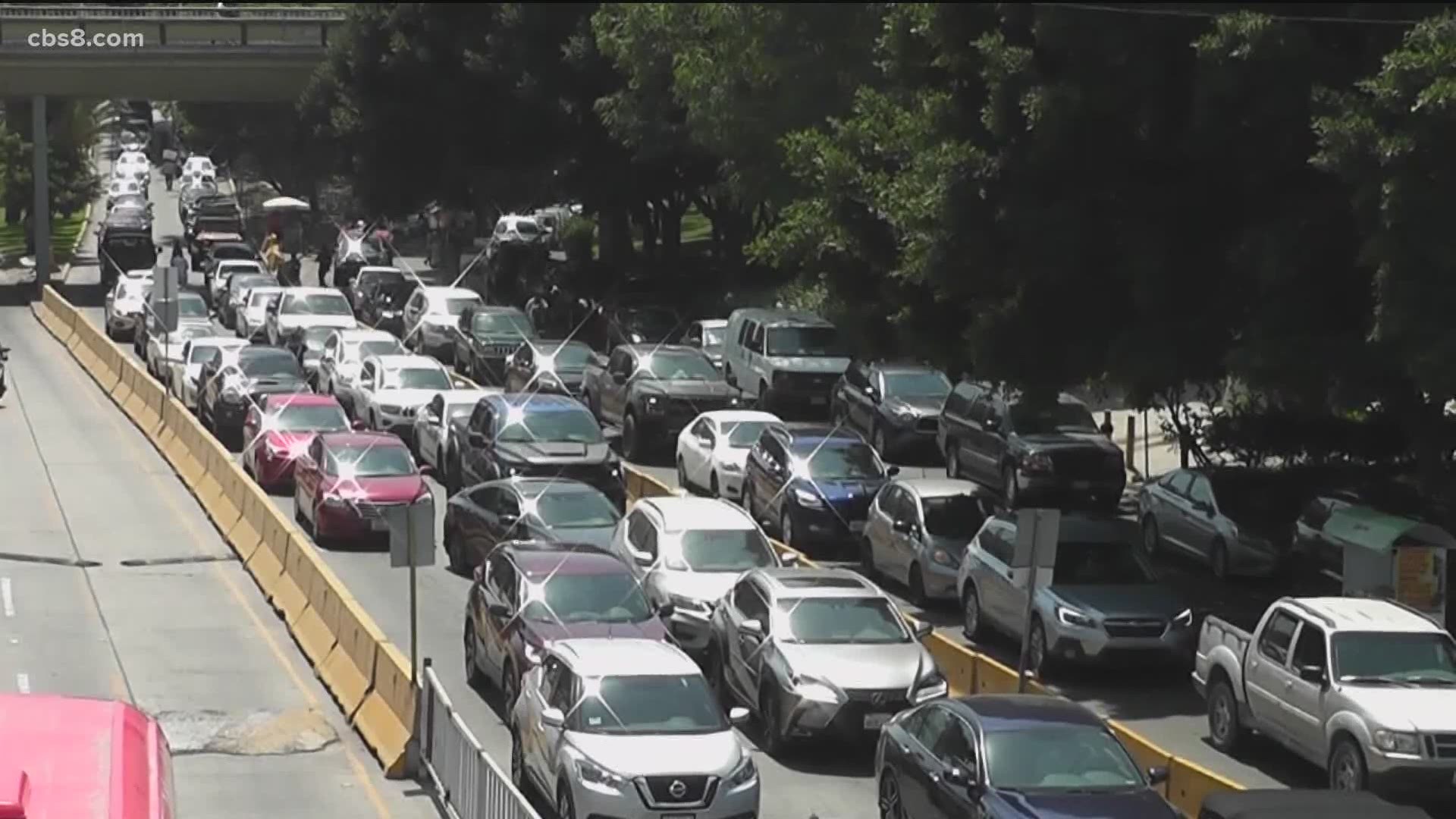SAN DIEGO COUNTY, Calif. — Border crossers have faced extraordinarily long lines to enter the United States over the past several days. U.S. Customs and Border Protection said it is “taking measures to discourage non-essential travel to and from Mexico to limit the spread of COVID-19 in the United States.”
A survey of more than 100,000 travelers conducted by the agency found a “vast majority” of Americans and permanent residents are crossing the southwestern border for non-essential reasons. Travel between the U.S. and Mexico has been restricted for essential purposes only since March.
Customs officers at San Ysidro, Otay Mesa and Calexico West have been referring non-essential travelers to secondary screenings where they are given a copy of the Travelers Health Advisory Notice from the Centers for Disease Control. The screenings take more time and have created a backlog of traffic and pedestrian crossers.
“I think it’s a bunch of hooey,” said Barbara Henwood as she waited to cross into the U.S. “[My husband has] got to go in starting next Monday every day for a 10-minute session of radiation. Fortunately, we have a medical pass. So hopefully, if we can find [the entrance], we’ll get there next week.”
The CDC updated its guidance last week and no longer recommends quarantining for 14 days after travel. However, it still encourages Americans to stay home and warns “you and your travel companions may spread COVID-19 to other people including your friends, family, and community for 14 days after you were exposed to the virus.”
The Tijuana Department of Public Safety assigned additional officers to help control traffic in the city. The agency estimated it took drivers upwards of eight hours to cross into the U.S. The delays caused significant traffic jams within the city over the weekend.
“We just said, 'we’ll spend the night and hopefully in the morning it won’t be long,'” said Jay Lopez as he waited to re-enter the U.S. “This [border wait] is the only thing that irritates me about it but you just have to have patience.”
Other drivers told News 8 they left their cars parked in Mexico and crossed on foot. While there were still some delays among pedestrian crossers, it was not as significant as those who tried to cross by car.
Several Americans who live in Tijuana complained to News 8 the delays caused them to be late for work in the U.S. Police said at least three drivers ran out of gas while waiting in traffic. Two people were arrested for illegal activity and a senior had a heart attack.
“It really has an effect on the east-west travel in the city of Tijuana. We haven't been able to quantify the value that [impact] represents,” said Gustavo de la Fuente, Executive Director of the San Diego-Tijuana Smart Border Coalition. “Long lines affect people traveling to work in their daily routine within the city. We've talked about the people who bear the brunt of this, which is, of course, many U.S. citizens and residents that are living in Tijuana, Rosarito.”
Custom and Border Protection stressed it is not turning away American travelers at the border. However, they should expect delays. The crackdown does not affect commercial traffic, such as trucks, which are not included in the Department of Homeland Security’s notice on travel to Mexico.
Mexico has also limited border crossings to those traveling for essential reasons. However, it has not staged a similar crackdown.
“Unfortunately, the Mexican side of the border, in this particular case, just does not have the personnel or the budget to actually do this. Historically, that's never really happened. If that starts happening, then we'll have a different kind of problem,” said de la Fuente.
His organization advocates for practical cross-border solutions and believes the recent effort will have an effect on non-essential travel.
“I think the lines are going to be much, much smaller,” de la Fuente said. “If the objective is to is to reduce the travel for non-essential activities, I think it is going to work.”
The Tijuana Department of Public Safety is directing drivers to use the following routes to mitigate congestion:
San Ysidro
-Regular: Calle Segunda and Calle Ocampo or Paseo los Heroes to the Independence Bridge
-SENTRI: Cenenario to Fray Servando St
-Ready Lane: Via Rapida East to Ermita Bridge
Otay Mesa
-Regular: Limon Padilla to Del Arbol traffic circle
-SENTRI: westbound Bellas Artes Blvd to SENTRI lanes
-Ready Lane: Airport road east toward the bus station

